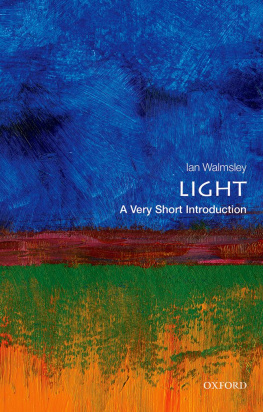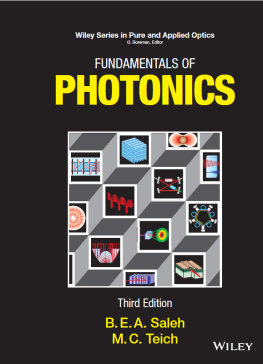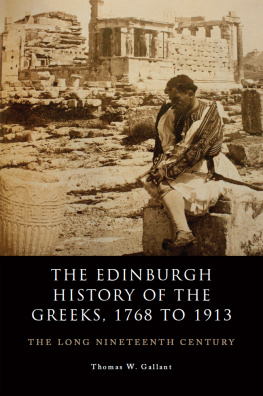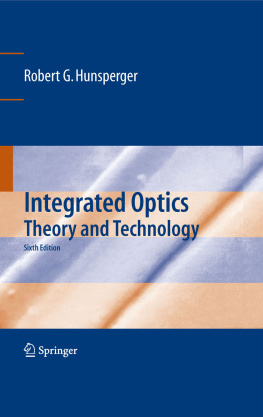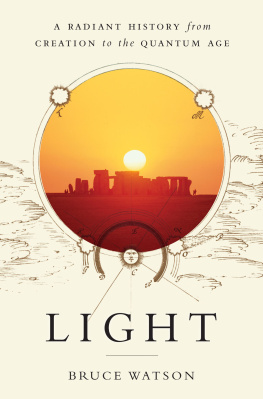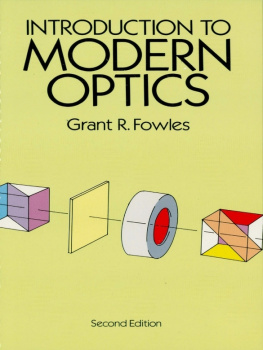A HISTORY OF OPTICS
FROM GREEK ANTIQUITY TO THE NINETEENTH CENTURY
A History of Optics
From Greek Antiquity to the Nineteenth Century
OLIVIER DARRIGOL


Great Clarendon Street, Oxford OX 2 6 DP
Oxford University Press is a department of the University of Oxford.
It furthers the Universitys objective of excellence in research, scholarship,
and education by publishing worldwide in
Oxford New York
Auckland Cape Town Dar es Salaam Hong Kong Karachi
Kuala Lumpur Madrid Melbourne Mexico City Nairobi
New Delhi Shanghai Taipei Toronto
With offices in
Argentina Austria Brazil Chile Czech Republic France Greece
Guatemala Hungary Italy Japan Poland Portugal Singapore
South Korea Switzerland Thailand Turkey Ukraine Vietnam
Oxford is a registered trade mark of Oxford University Press
in the UK and in certain other countries
Published in the United States
by Oxford University Press Inc., New York
Olivier Darrigol 2012
The moral rights of the author have been asserted
Database right Oxford University Press (maker)
First published 2012
All rights reserved. No part of this publication may be reproduced, stored in a retrieval system, or transmitted, in any form or by any means, without the prior permission in writing of Oxford University Press, or as expressly permitted by law, or under terms agreed with the appropriate reprographics rights organization. Enquiries concerning reproduction outside the scope of the above should be sent to the Rights Department, Oxford University Press, at the address above
You must not circulate this book in any other binding or cover
and you must impose the same condition on any acquirer
British Library Cataloguing in Publication Data
Data available
Library of Congress Cataloging in Publication Data
Library of Congress Control Number: 2011945380
Typeset by SPI Publisher Services, Pondicherry, India
Printed and bound by
CPI Group (UK) Ltd, Croydon, CR0 4YY
ISBN 9780199644377
1 3 5 7 9 1 0 8 6 4 2
PREFACE
For the last few years, I have taught the history of optics to successive students at the Universit Denis Diderot and at the Ecole Normale Suprieure in Paris. While preparing this course, I was impressed by the abundance and depth of recent research on specific aspects of this history. At the same time I noticed the lack of a concise, long-term history that would integrate the results of this research. The present book is aimed at filling this gap. Its broad scope and its conceptual orientation are meant to appeal to physicists and opticians who are interested in the history of their discipline, to historians who wish to grasp or teach the essentials of an attractive domain of the history of science, and to philosophers who know that optics often informed the philosophy of knowledge. No special mathematical competence is required from the reader, except for a few sections of the three last chapters covering the inherently more mathematical optics of the nineteenth century.
Nowadays, optics is commonly defined as the science of light and vision. It comprises a variety of topics including the fundamental physics of light, ocular vision, optical instruments, and the business of corrective lenses. Going back in time, the chain of backreferences leads us to the ancient Greeks, who defined optics as a theory of vision. It is therefore natural to begin a history of Western optics with the Greek contributions, even though Greek optics did not have light as its main protagonist. It is also natural to end the narrative in the late nineteenth century, since classical wave optics reached its maturity around that time. In the two first millenaries of this long evolution, optics remained mainly a theory of vision and its history should therefore be recounted as such. For the next three centuries, following Keplers intervention, there existed a fairly autonomous domain of physics concerned with the behavior of light. Most of the present book focuses on this narrower optics, with incidental references to relevant developments in acoustics, photochemistry, color perception, and spectroscopy.
Even with this significant restriction, it is impossible to write a compact long-term history of optics without taking further measures of economy. A first difficulty comes from the enormous variations of the cultural and disciplinary contexts in which optical knowledge was produced. I provide the necessary minimum of information about these contexts, and refer the reader to secondary literature for further examination. For instance, I take the seventeenth-century mechanization of the world picture as a given, and I do not enter the debates on its various causes. I save further space by avoiding meta-historical questions, such as: Was Alhazen a revolutionary? Was Kepler the last of the ancients or the first of the moderns? Did Thomas Young deserve the contemporary neglect of his undulatory theory? When dealing with nineteenth-century optics, I save ink by being very brief on aspects that are usually covered in histories of electrodynamics, relativity, or In presenting mathematical developments, I use concise modern notation as long as this does not alter the structure of the historical actors arguments.
By trimming the narrative in these ways, I aim to highlight conceptual contents and interconnections. I apply two other strategies to this end. First, I pay more attention to the actors long-term memory than could be done in studies confined to short periods of time. The main optical writers usually situated themselves within or against earlier traditions that spanned many generations. Their innovations largely depended on their creative reading of masters of a remote past. For example, seventeenth-century optical writers frequently referred to Greek philosophy and optics; Eulers theory of light largely reproduced anterior neo-Cartesian views on light; and Youngs innovations depended on his erudite knowledge of the physics of sound and light from the Greeks to his time. Secondly, I examine the history of acoustics and the extent to which the leading opticians explored and deployed analogies between sound and light. Contrary to a well-spread opinion, the basic concept of sound as a compression wave was not available until the last third of the seventeenth century. In earlier times there were several concepts of sounds deriving from the ancient Greek notion of sound as a breath of air. This lack of a consensus on the nature of sound made it difficult to construct optics by analogy with acoustics. More generally, wave concepts that are now regarded as basic only entered acoustics a little before or even at the same time as they entered optics. Keeping this fact in mind helps clarify the timing and contents of the various wave theories of light.
describes some highly mathematical contributions to nineteenth-century optics that did not depend on the deeper constitution of the ether: Hamiltons theory of systems of rays, Kirchhoffs and others diffraction theories, and Gouys and others introduction of Fourier analysis in discussing optical coherence and the nature of white light.
In preparing this book, I found much inspiration in the works of a number of historians of optics including David Lindberg, Grard Simon, A. Mark Smith, and Roshdi Rashed on Greek and Arab optics; Abd al-Hamid Ibrahim Sabra on Alhazens and Descartess optics; Catherine Chevalley on Keplers optics; Alan Shapiro on many aspects of seventeenth-century optics; Michel Blay on Newtons optics and on rainbow theory; Fokko Jan Dijksterhuis on Huygenss optics; Geoffrey Cantor on British eighteenth-century optics; Casper Hakfoort on Eulers optics; Fabrice Ferlin on dAlemberts optics; Jean Eisenstaedt on some aspects of Newtonian optics; Nahum Kipnis on Youngs principle of interference; Jed Buchwald on early nineteenth-century optics; Andr Chappert on Malus and on post-Fresnel optics; and Edmund Whittaker on mechanical theories of the ether. There are of course many more relevant secondary sources, a significant fraction of which is cited in the footnotes and listed in the bibliography. When many authors cover the same topic, contradictory viewpoints and interpretations are inevitable, and for this reason, among others, I have anchored my own analysis on the reading of primary sources. I found this imperative for treating some aspects of this long history, such as French neo-Cartesian optics, optics in the second half of the nineteenth century, or the connection of optics with acoustics where secondary sources are much less abundant, or weaker.
Next page


